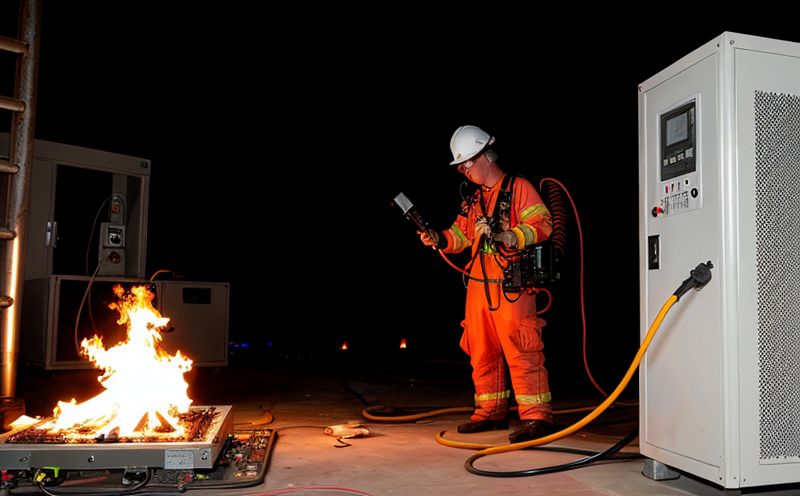Fire Safety Assessment of Printed Circuit Boards (PCBs)
The fire safety assessment of printed circuit boards (PCBs) is a critical aspect of ensuring the reliability and safety of electronic devices across various sectors. This service focuses on the testing, evaluation, and certification of PCBs to ensure they meet stringent fire safety standards. The primary goal is to identify potential risks that could lead to fires or other hazards during use or in case of accidental exposure to ignition sources.
Electrical and electronic equipment, particularly those containing PCBs, are subject to rigorous testing to comply with international standards such as UL 94, IEC 60335-1, and EN 60335-1. These standards set forth specific criteria for the flammability of materials used in these devices. The fire safety assessment process involves a series of tests that simulate real-world conditions to determine how well PCBs can withstand ignition without spreading flames or releasing toxic fumes.
The testing begins with thorough specimen preparation, where PCB samples are cut to standard sizes and cleaned to ensure consistency across all test runs. Various methods of ignition are then applied, including open flame, hot wire, and needle puncture tests. These tests help in understanding the material's behavior under different types of fire exposure.
After the initial testing phase, a detailed report is generated that includes the results from each individual test along with recommendations for further modifications or improvements if necessary. This comprehensive approach ensures that any potential risks are identified early on and addressed promptly to prevent accidents in end-user applications.
The importance of fire safety assessments cannot be overstated, especially given the increasing complexity of modern electronic devices. By adhering strictly to international standards and employing advanced testing methodologies, this service provides assurance that PCBs meet the highest level of safety requirements. This not only protects consumers but also helps manufacturers comply with regulatory expectations.
Some key industries benefiting from such assessments include automotive, aerospace, medical devices, consumer electronics, and telecommunications. Each sector has unique challenges when it comes to fire safety, making thorough evaluation essential for maintaining quality and reliability throughout the supply chain.
| Industry | Key Considerations in Fire Safety Assessment |
|---|---|
| Aerospace | Ensuring lightweight materials do not compromise fire safety |
| Automotive | Meeting stringent regulations for vehicle interiors and components |
| Medical Devices | Preventing fires that could endanger patient safety |
| Consumer Electronics | Avoiding recalls due to fire hazards in household appliances |
| Telecommunications | Protecting equipment from accidental ignition in high-density environments |
In conclusion, the fire safety assessment of PCBs is an integral part of ensuring product quality and enhancing consumer confidence. Through rigorous testing procedures and adherence to international standards, this service guarantees that electronic components meet the highest levels of fire safety.
Industry Applications
- Aerospace: Ensuring lightweight materials do not compromise fire safety
- Automotive: Meeting stringent regulations for vehicle interiors and components
- Medical Devices: Preventing fires that could endanger patient safety
- Consumer Electronics: Avoiding recalls due to fire hazards in household appliances
- Telecommunications: Protecting equipment from accidental ignition in high-density environments
The fire safety assessment of PCBs plays a crucial role across these diverse industries, helping manufacturers comply with regulatory expectations and enhance product reliability.
Quality and Reliability Assurance
- Conformance to International Standards: UL 94, IEC 60335-1, EN 60335-1
- Detailed Reporting: Comprehensive analysis of test results with actionable recommendations
The quality and reliability assurance process for fire safety assessments involves strict adherence to international standards. These include UL 94 for flame retardancy, IEC 60335-1 for electrical devices, and EN 60335-1 for similar European standards. Compliance with these guidelines ensures that the PCBs meet stringent requirements regarding flammability and heat resistance.
A detailed report summarizing all test outcomes is provided after each assessment. This document not only lists the results but also offers insights into any areas requiring improvement. Such information helps manufacturers make informed decisions about design changes or material substitutions, thereby enhancing overall product quality.
International Acceptance and Recognition
- UL 94 Flame Retardancy: Widely accepted in North America
- IEC 60335-1 and EN 60335-1 Electrical Safety Standards: Recognized globally for electrical devices
The fire safety assessment of PCBs is internationally recognized, with several standards being widely accepted. The UL 94 flame retardancy standard is particularly popular in North America, while IEC 60335-1 and its European counterpart EN 60335-1 are globally respected for their comprehensive approach to electrical safety.
These standards ensure that PCBs not only perform well within specific environments but also maintain consistent performance across different regions. This global recognition enhances the credibility of manufacturers who adhere to these stringent requirements, fostering trust among buyers and end-users worldwide.





